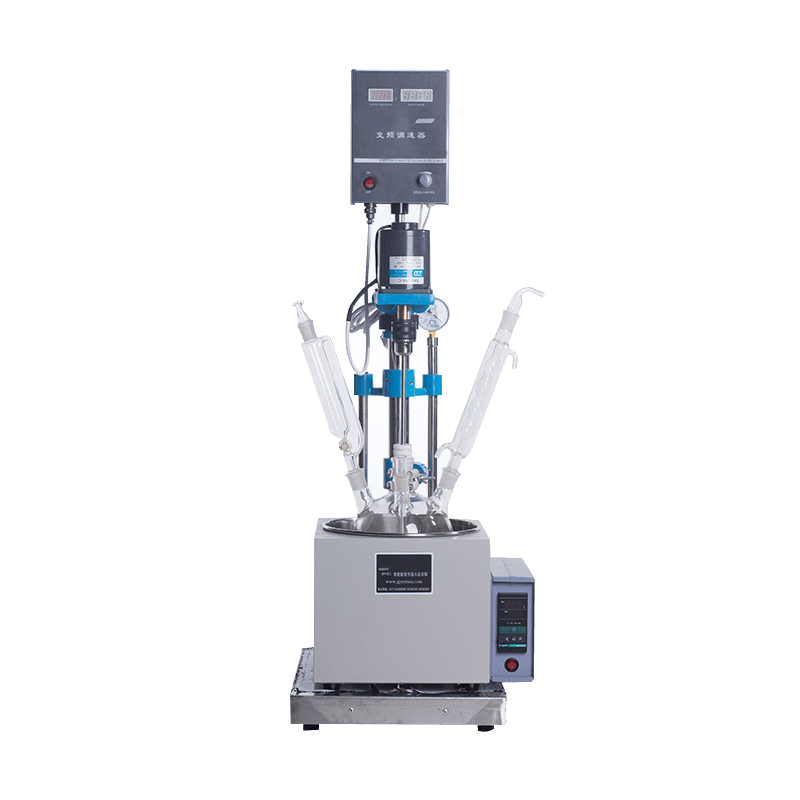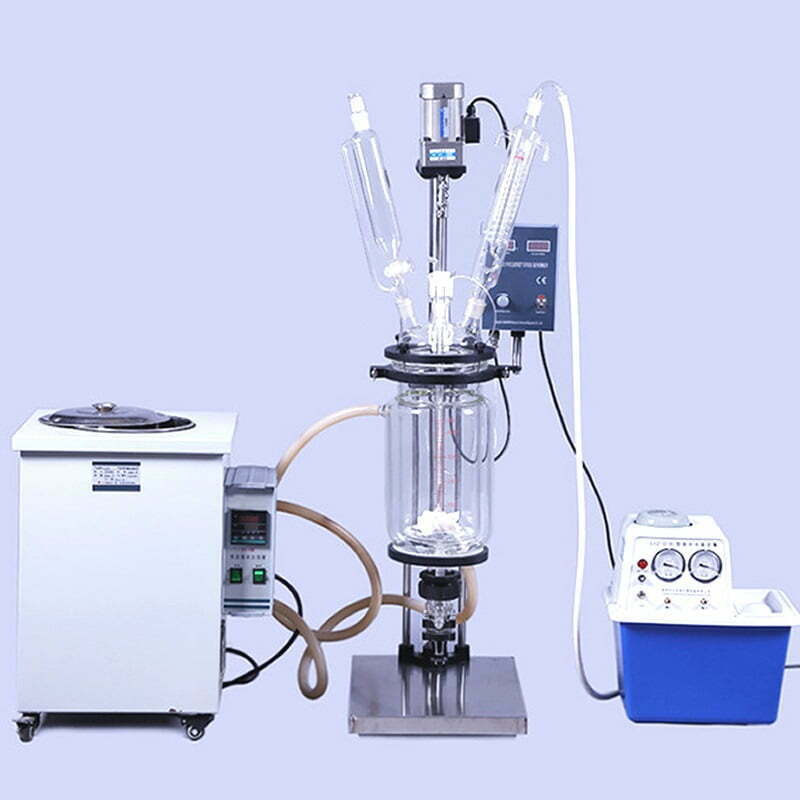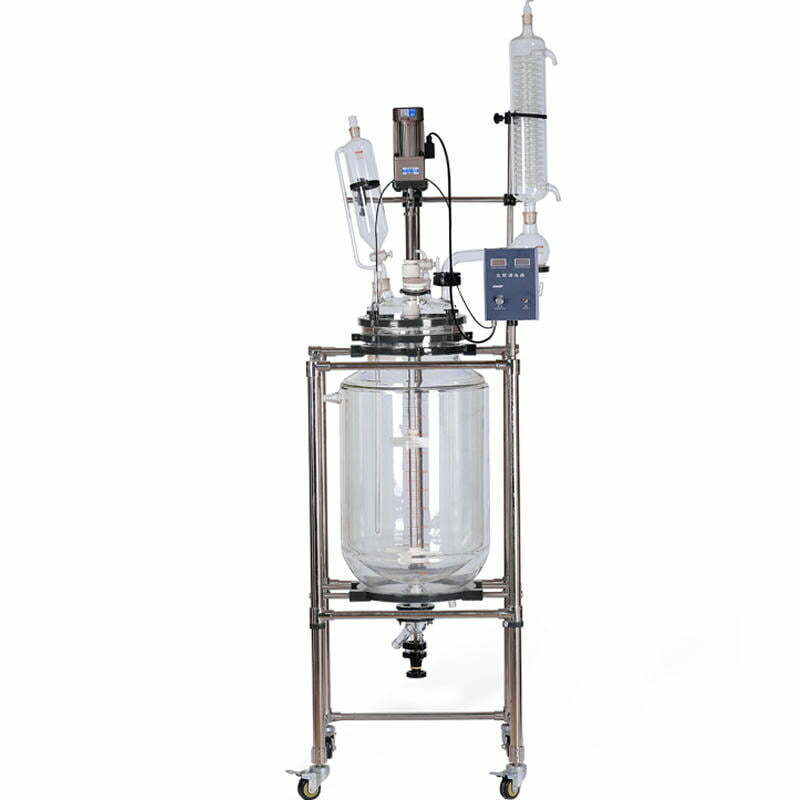A jacketed vessel is a container that is designed for controlling temperature of its contents, by using a cooling or heating “jacket” around the vessel through which a cooling or heating fluid is circulated. The jacket has ability to permits the uniform exchange of heat between the fluid circulating in it and the walls of the vessel.
Jacketed glass reactors are designed for reaction and mixing of different types of materials under a specific adjustable temperature and vacuum condition. The reaction lid has different functional ports which allow users to perform different purposes such as adding material to the vessel at a controlled speed, measure the temperature of material, add powder or solids to the vessel, recover the distilled material and so on. The lid is fully customizable according to clients’ requirements.
The Principles of Jacketed Glass Reactor
Jacketed glass reactor is one of the important types of glass reactors. It is a compartment designed to control the temperature of its material, using a cooling or heating “shell” around the reactor through which a refrigerant or heating fluid circulates. The housing can allow a uniform heating trade between the circulating fluid and the vessel joints.
There are several notable jacket reactors, which include: dimple jacket, paint rings, medium pipe curl jacket, and conventional jacket. These jackets have their highlights. As a type of chemical reactor, an encapsulated one is generally used to eliminate the high heat of the response or to reduce the thickness of highly viscous liquids. Especially, cooling jackets have a vital function.
The chemical response releases heat, and this energy causes the material to overheat in the reactor; For this reason, the feed continues to become a faster element and releases more heat. The cooling jacket can stop progressively upwards to increase the humming temperatures. That will result in doubling the response rate that results in increased heating. The cooling fluids flow through the housing, collecting thermal energy from outside the reactor.
What-is-a-glass-reactor
The reactor jacket has different useful ports that allow users to perform various purposes. The purposes include adding materials to the reactor at a set speed, measuring the temperature of the materials, adding dust or solids to the reactor, and recovering refined materials. The jacket is fully customizable according to customer requirements.

jacketed glass reactor System
The jacketed reactor has several advantages. For example, we are giving a higher amount of flow in general because the weight is reduced through a lower area than if the entire deck is a separate zone, and the ability to direct the flow to specific parts of the housing.
With everything in mind, the jacketed reactor can be widely used in fields such as food, chemicals, pharmaceuticals, color, and various institutions. If you buy one, you can discover more and more useful data on the web these days.
Features of a Jacketed Glass Reactor
GG17 high-borosilicate glass with nice physical-chemical properties; experiment temperature -100 to 400 degree C; Resistant to strong acidic properties of materials; only touching with glass parts & PTFE, no cross-contamination.
Double cylinder; kettle cover is separated from kettle body. It is convenient to disassemble, clean and install.
Stirring adopts to mechanical sealing, it keeps higher vacuum degree among the same products in the market. It also keeps high vacuum degree when stirring.
Glass(PTFE)discharge valve, non-dead angle mixing, fast emptying, no residue.
Frequency control speed gear motor, smooth running,high torque, automatic booster, no spark, noise free, long life.
SUS frame and cast aluminum material kettle body support, elegant appearance, stable structure.
Circulating water/oil bath, high and low temperature machine can supply heating source; Cooling machine:cooling chiller,high and low temperature machine,convenient and practical .
Scientific & innovative structure, practical, elegant appearance,domestic industry-leading.
The Applications of Jacketed Glass Reactor
1.Jacketed Glass Reactor in Lab
Jacketed glass reactors are used in various places such as the laboratory, chemical industries, pharma industry and they are used in chemical engineering where they are used for various kinds of reactions. This vessel is very popular and they are available in different shapes, sizes, and qualities. shapes and sizes you buy depend on the kind of reaction you want to do.
If you want to use it in the laboratory, you must ensure that it meets the parameter configuration such as evaporation reaction, heating reaction, as well as speed and cooling effect. The design is such that it can meet the functions and other things that you want to achieve with it. For your laboratory research, You can use this to carry out different kinds of reactions. There is no other reaction vessel that can compare with it. This is because it is perfect as it ensures reactants mixing and synthesis. In the laboratory, you can subject this to different kinds of reactions such as extraction reaction, homogeneous reaction, and most importantly distillation reaction as well as sample purifications and so on.
Jacketed glass reactors for use in the laboratory are often designed with the finest quality raw materials that are available in that industry. This is necessary to ensure that the reactants do not cause any harm. Most of them are designed using G-17 high-temperature borosilicate glass material. This is specifically meant for low expansion reaction, and it can work perfectly under high temperatures. Before you begin to use this, you must ensure that it is safe to use.
Check whether it is a quasi-glass material and if it is such, then you would know that it is safe to use. Most importantly, you must be aware of the various rules that you can use this type of glass in the laboratory and you must ensure that you meet that requirement to ensure that you get a piece of accurate information.
2. Jacketed Glass Reactor in Chemistry
20l-jacketed-glass-reactor-jacketed-heating-glass
In the chemistry laboratory, especially in schools, these jacketed glasses are used to carry out different kinds of reactions. The way you use the jacketed glass reactor in the laboratory is almost the same as how you can use it in chemistry. This type of glass is unique because it has multipurpose uses.
For instance, just as you can use it in the laboratory, you can use it in the pharma industry, the chemical engineering industry and so on. It almost works on the same principle. The most important thing is to ensure that it meets the specification for that industry standard.
The glass reactor is in different capacities and ensures that the model you want to use meets the specification for that industry. In the chemical industry, it must meet the required specifications. Most of the glasses that are used for this kind of operations are often heated to ensure that chemicals mix very well.
There are lots of reactions you can do with this jacketed glass reactors in chemistry laboratories across the world such as the combination reaction. This involves a combination of two or more chemicals. Another type of reaction you can use it for includes decomposition reaction, where you break down chemicals to their components. Most importantly, you can use them for redox reaction, combustion reaction, as well as double replacement reactions and even single displacement reactions.


